11 Types of Content Marketing that Drive Great Results
Content marketing opens an array of opportunities for brands to promote themselves and their products. Without content marketing, you won’t have much brand recognition, and your chances of outcompeting your rivals will be lower.
At the same time, content marketing is complex. It includes a wide variety of content types, and one can get lost in choosing the one that can help achieve a specific result.
If you can relate, we have a list of 11 content types that can help boost the performance of your content marketing strategy.
Let’s dive in!
What is Content Marketing?
Content marketing is a digital marketing strategy that involves creating online material focused on promoting a brand and its products, attracting new leads, increasing conversions, improving sales, and raising awareness.
Although this article gives an overview of content marketing as a part of digital marketing, it would be unfair to say that it’s only used within this field.
In our Content Marketing Guide (make sure to check it out), we mentioned that content marketing can be traditional and digital. In the first case, it is distributed through traditional media, such as newspapers, radio, and television. When talking about digital content marketing, we imply such distribution options as blogs, social media, etc.
The ultimate goal of a content marketing strategy is to improve brand authority. When a consumer sees your business and product as trustworthy, you will see positive results in lead generation, sales, and all other objectives you’re trying to reach with content. That is, if your content strategy is effective.
And how do you know it is?
In theory, a high-quality content strategy relies on the following pillars:
- Audience personas with clearly defined needs
- Brand positioning
- A business case
- An owned media value proposition
- An action plan
So, essentially, you need to have a target audience that has a need for your product. The content targeting this audience reflects your brand’s image and shows distinct value across all owned media. All of this is supported by a business case with specified goals and an action plan defining how content will be used to achieve these goals.
If your content marketing strategy ticks all the boxes, it can bring tons of benefits. Let’s talk more about them in our next section.
3 Benefits of Content Marketing
Obviously, content marketing today is something you can’t just pass by and leave without attention. The fact that 97% of companies worldwide have a content strategy in place is already a good enough reason to invest in content creation.
However, if mimicking others is not really your type of motivation to start something, here are some tangible benefits of content marketing to consider.
Benefit #1: More organic traffic
According to SEMrush’s research, 37% of companies use content marketing to get more organic traffic.
Why?
The answer is pretty simple – the more your website appears in SERPs, the more visitors it will get. More visitors potentially equal more sales, conversions, higher trust, and improved brand awareness. The key medium here is, you guessed it, content.
However, not all content will deliver organic traffic. Here, content marketing is closely connected to SEO and, in particular, how well you can optimize content for keywords that both bring traffic and match specific search intent.
We’re not going to go into detail on this right now, as SEO is a very extensive topic. But make sure you check out our recent guides on B2B SEO and SaaS SEO – there are quite a few valuable insights there.
To prove that content can deliver organic traffic, let’s take a look at the performance of our own website, Digital Marketer’s World.
While doing extensive keyword research on social media marketing, one of the digital marketing pillars we’re covering on our blog, we picked a keyword later vs hootsuite, understanding that our readers would be searching for these social media marketing platforms and comparing them. The keyword has a pretty decent search volume, so we bet on it to drive traffic to our website. And it did, bringing us 782 clicks and 4.34K impressions within six months:
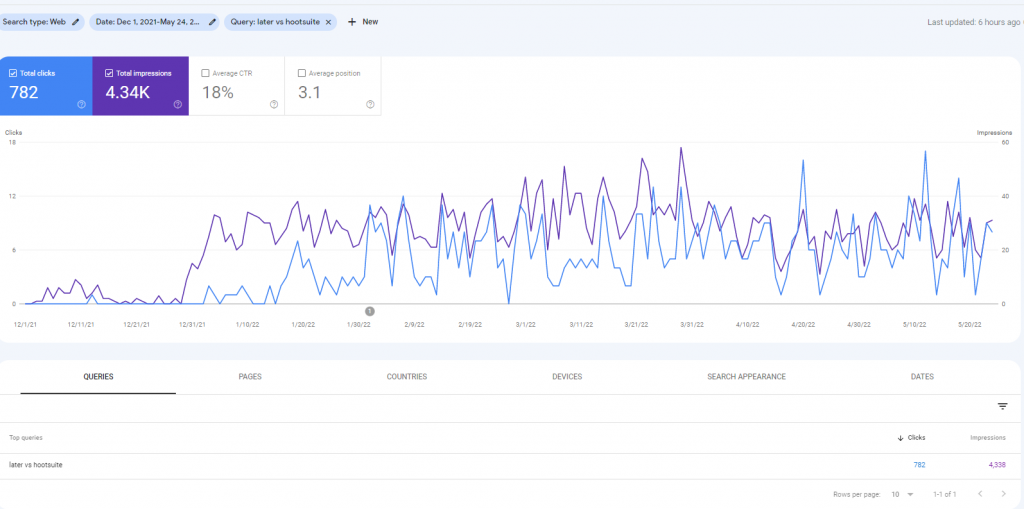
These results are not bad for a blog that’s only getting on its feet. However, it also depends on the quality of the content. The keyword stuffing days are long gone – now, Google expects you to deliver in-depth, high-quality pieces that deliver certain value. Otherwise, the traffic that the content brings you can hardly be considered useful.
Benefit #2: Expanded brand awareness
Going back to the SEMrush study mentioned in the previous section, the overwhelming majority of respondents (45%) said their main goal of using content is to raise brand awareness. Why is that?
Expanded brand awareness helps businesses achieve an entire range of objectives, including:
- Improved lead generation
- Brand affinity
- Brand loyalty
Essentially, the more people know your brand, the more opportunities you have to tip the scale for your benefit and outrun your competitors, becoming a thought leader in your industry. That is why awareness stands at the top of the sales funnel (we touched upon it a bit in the above-mentioned SaaS SEO guide and our Email Marketing Funnel article).
The top-of-the-funnel (TOFU) content aims to tell the world about your brand, its values, and, of course, the product. At this stage, you can involve the following content types to raise awareness:
- Blog articles
- Videos
- Podcasts
- Guest posts
- Infographics
- Email newsletters
- Interviews
- PPC ads
Let’s give a more specific example. If we take video content to raise brand awareness, you can film a tutorial video on how to use your product. The reason? People who have been recently introduced to your brand will want to see how your product works, and it will be reflected in the number of views. For instance, Hootsuite’s How to Use Hootsuite in 13 Minutes video has 239K views, which is considerably more than its introductory What is Hootsuite video, with only 92K views:
In general, the more you bet on educating your target audience with your content, the better results it will bring in terms of brand recognition.
Benefit #3: More leads
As we’ve figured out, one of the common content marketing goals is to help brands generate leads. Companies share different content types via various distribution channels to target potential prospects, and statistics say it is highly possible that these efforts can be successful.
For instance, here’s what HubSpot has shared:
- 83% of marketers have been able to generate leads with product videos
- 53% of respondents claimed emails bring the most prospects at the top of the funnel
- Another 53% of marketers say webinars helped them bring in more potential clients at the early lead generation stage
Content used for lead generation has specific characteristics. It usually informs a prospect about the benefits and values of purchasing a product or service and does it in a way to encourage them to go to the next step with a call-to-action (CTA).
For instance, HubSpot has created a library of eBooks and uses it as a way to collect prospect emails to expand its lead list. Essentially, if a lead is interested in this book, they will hit the CTA button to download it, but the prerequisite to getting it is to provide their personal details:
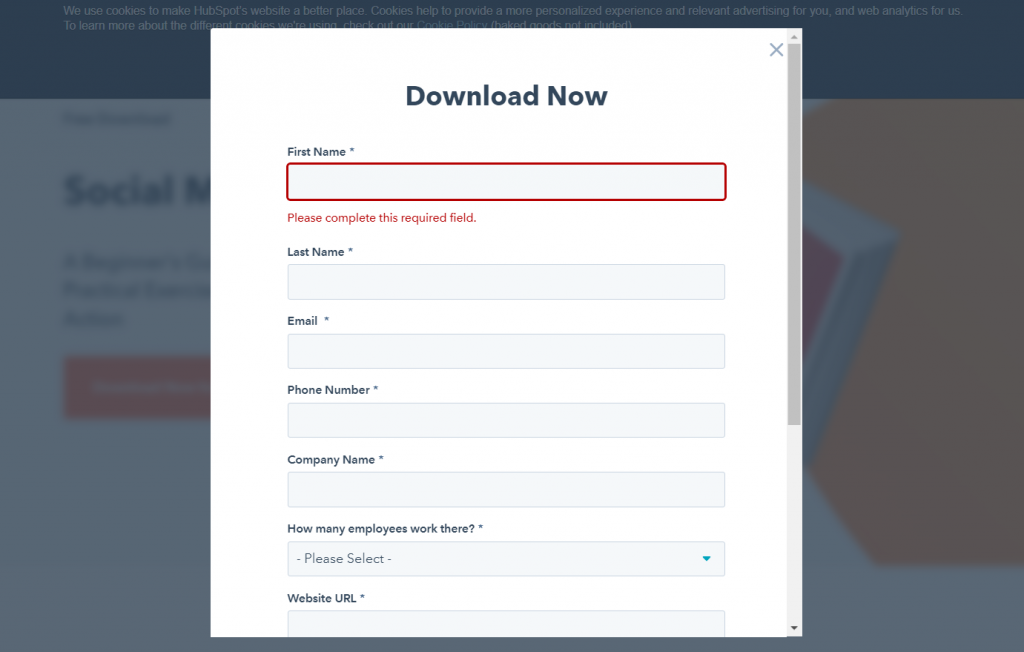
In other words, HubSpot uses its eBooks as lead magnets.
Another example comes from Paperbell coaching software that creates content that solves a micro problem for their specific niche (life coaches). One of their top performing content is their piece on life coach intake forms which includes everything a coach needs on the topic including exactly how to set up the form and questions to ask. The blog post has a 3% conversion rate to Paperbell’s lead magnet, which then leads to a free account.
If you want to see more examples like this, check out our 25 Lead Magnet Ideas article for inspiration (the list includes templates, cheat sheets, toolkits, swipe files, demos, quizzes, and many more) .
Alright, now, as it’s all clear with the definition and the benefits of content marketing, let’s go over the 11 different types of content marketing you can use to achieve goals and drive tangible results.
Type #1: Blog Posts
A blog post is a content piece published in the blog section of the website. It can be an article, a guide, a news piece, etc. The goal is to answer the question the reader is interested in and to help them learn about your brand and product.
Today, you can hardly find a business that doesn’t have a blog. Back in 2018, half of the top 200 Fortune 500 companies had a corporate blog and were actively using it. Today, this number is definitely bigger.
The obvious reason to run a blog is to generate brand awareness. However, there are a few other objectives brands can achieve with a successful blog:
- Increased traffic
- More new prospects
- Lead nurturing
- Improved conversions
- Higher authority in the niche and industry
So, regular blogging can help your business become more recognizable. However, every experienced blogger knows that a lot depends on the quality of your posts. Quality blog content should possess the following characteristics:
- Uniqueness
- Consistency
- In-depth research
- Dynamics
- Eloquence
All of these factors boil down to one crucial characteristic of a good blog post – it should educate in a practical manner that helps the reader make helpful takeaways. This can be achieved not just with the help of text but also with visual content integrated into it.
A good example of such a post is Ahrefs’ Branded Search vs. Non-Branded Search: What’s the Difference article. To answer the question in the title, the writer uses both text and infographics:
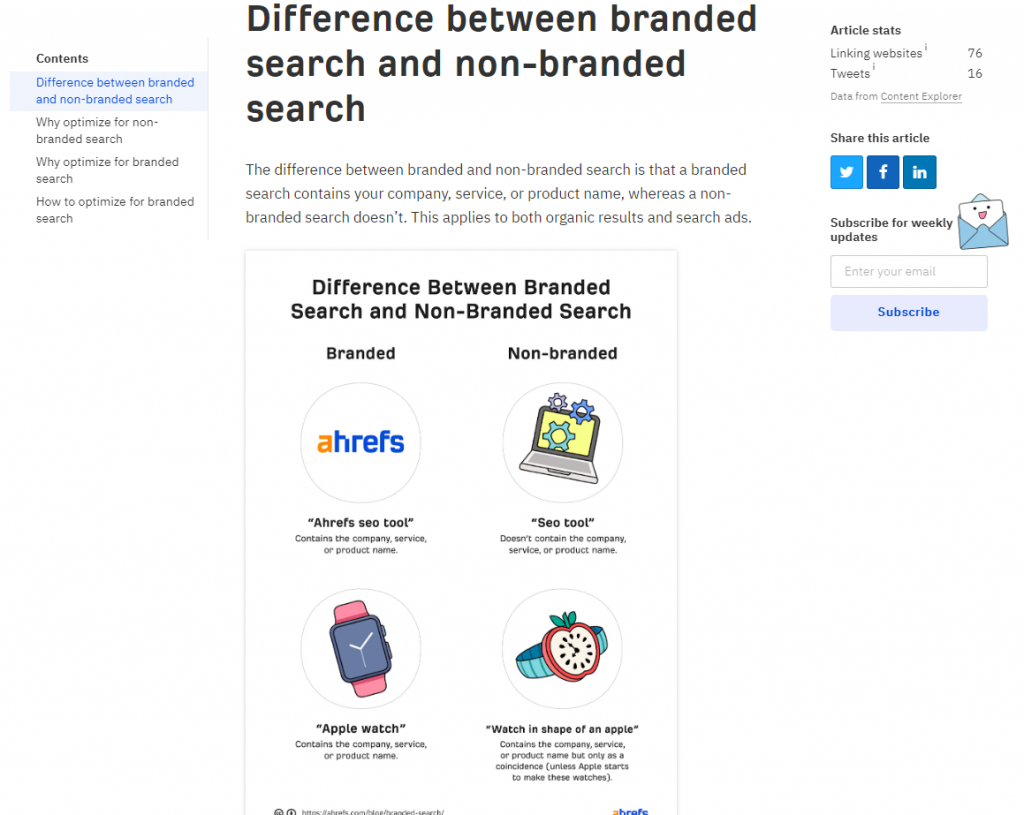
Next, the writer explains how to optimize content for branded and non-branded search using Ahrefs’ solution. It can be perceived as a promotion, but it is done in such a subtle manner that it’s almost not noticeable. As a result, Ahrefs both educates the reader and promotes the product, proving its value.
Now, let’s go over to our next content type.
Type #2: Videos
Video content includes a variety of content formats that feature a video in some way or another. It can be a regular video, a GIF, or a live stream. Live broadcasting on social media, such as Facebook, Instagram, and TikTok, also belongs to video marketing.
You already know the effectiveness of including videos in your marketing campaigns (we mentioned some HubSpot statistics a bit earlier). Video content can take many forms depending on your goals and the customer journey stage.
For instance, let’s say you want to target prospects at the conversion stage and help them make a decision to become paying customers. In this case, you can use testimonial videos to prove your product’s worth and help the prospect make the final purchase decision.
Databricks, an enterprise software company, has an excellent example of a customer testimonial video featuring its client, Showtime, a premium streaming network:
Essentially, it is an interview with a customer who tells the success story of using Databricks and how it helped accelerate their data pipeline. He explains these successes in numbers, which helps convince the viewer that Databricks is, in fact, a solution worthy of their attention.
If you’re interested in more examples of videos for each sales funnel stage, we’ve covered them in our Video Marketing guide. Now, let’s take a look at podcasts and how they can help you achieve your marketing goals.
Type #3: Podcasts
A podcast is a piece of content in an audio or video format which can be distributed through digital channels. For instance, you can run a podcast on your website, YouTube, social media channels, and platforms like Spotify.
At first glance, podcasts may not seem that important. After all, you have blogging, video marketing, and social media marketing to pay attention to, so why should you consider running podcasts as well?
Well, statistics show that people gladly consume this content type. Take a look at what Convince and Convert has discovered:
- 57% of Americans have listened to a podcast
- 41% of Americans listen to podcasts monthly
- 40% of respondents consume one to four podcasts a week
What about the benefits of this kind of content marketing-wise?
Here are some compelling numbers from BuzzSprout:
- 60% of listeners have bought something advertised during a podcast
- 69% of listeners say podcast ads increased their brand awareness of a brand
So, a podcast can definitely help you increase sales. However, this is not why you should start podcasting in the first place.
The main goal still should be to educate. Ideally, a podcast episode should answer a particular question, like a blog post. However, a podcast gives you a chance to do it in a more authoritative way. For instance, by inviting experts from your industry, like Minuttia does in its podcast episodes.
Here’s an example of a conversation between Minuttia’s managing director George Chasiotis and Mordy Oberstein, the Head of Communications at SEMrush, on SEO metrics:
This episode doesn’t just talk about SEO in general; it goes into specifics of using data in search engine optimization, which is more valuable to the listeners in this niche. Besides, the episode is full of real-life case studies, making it a great example of how podcasts should be done.
Next on our list are infographics, so let’s discuss what they can do for your content marketing strategy.
Type #4: Infographics
An infographic is a visual representation of data with the goal of making it more clear and digestible to the reader. Infographics often come in the form of graphs and can be standalone or included in a blog post. It’s also a great idea for repurposing content from your blog.
The usual size of an infographic is 600×1800 pixels, and it should possess the following characteristics:
- It should include a descriptive title and subtitles
- The data should be broken down into meaningful blocks
- The color scheme should correspond to your branding
- Data density should be straightforward enough not to overwhelm the target reader
- Data visualization should be simple enough for an average reader
- The infographic should provide clear and valuable information
A good example featuring all these characteristics is the infographic by Stephanie Phung, the creator of carbonhealth.com, called Ocean Pollution:

It provides the main facts on the topic, giving a visual representation of the data related to it. You can see a clear division into meaningful blocks – what water pollution does to people and sea life. It’s dynamic, and data density is medium, which is enough to perceive the information with ease. But most importantly, there is a clear takeaway showing how much water pollution costs the global economy.
Which marketing goals can infographics help you reach?
First and foremost, they can help you drive traffic. If you combine infographics with your SEO-optimized blog posts, they can increase website traffic by 12%. Apart from that, this form of content is great for brand awareness. If your infographic shares valuable and unique information, companies from your niche will want to share it, boosting your brand recognition. Besides, you can also use this content type as a linkable asset to get backlinks.
Now, it’s time for our next content type – eBooks.
Type #5: eBooks
An eBook is usually an electronic version of a printed book that you can read on digital devices. However, marketing eBooks often exist in a digital-only format.
What are eBooks used for in marketing?
Usually, the primary purpose is to generate website leads. You’re already familiar with HubSpot’s example above. Here’s one more example from Later – it is an eBook describing the 2022 social media design trends, and you can access it after sharing your email address, industry, and location:
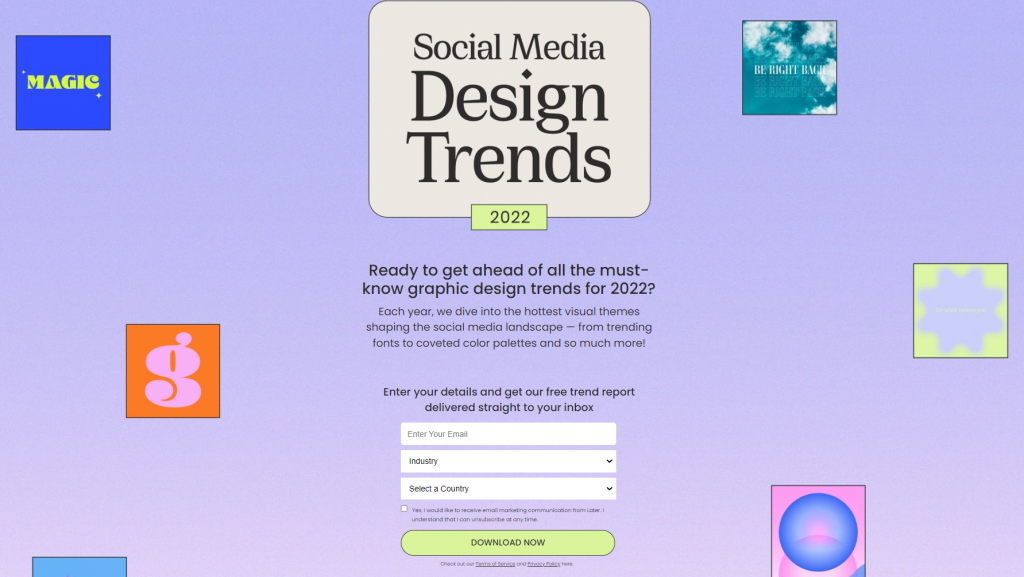
Once you subscribe, you can download the pdf format of the eBook with visual examples of the hottest social media design trends:
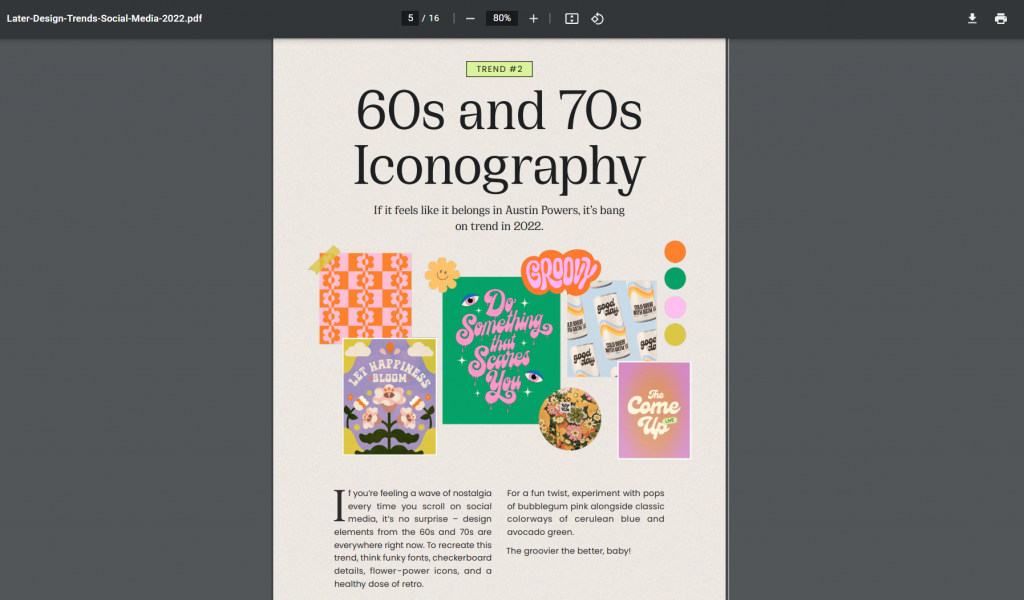
Of course, not every eBook is born equal. Sometimes brands abuse this format of content to get leads, but when you actually download the eBook, it doesn’t provide anything valuable.
If we consider Later’s example, its eBook is based on original research, so it’s worth sharing your contact details to get it. Another component that makes this example excellent is the color scheme that corresponds to Later’s approach to branding and proper data visualization. The book is printable and mobile-friendly and features a CTA at the end, inviting you to try Later’s visual planner to improve your social media marketing efforts.
You can turn anything into an eBook – case studies, white papers, research, and any long-form content. The options for content repurposing here are endless.
Now onto our next content type – reviews and testimonials.
Type #6: Reviews and Testimonials
A customer review is a consumer’s opinion of a product or service after purchasing and using it for some time. A review can be positive or negative.
In its turn, a customer testimonial is a product review and recommendation from a satisfied client, usually given upon the brand’s request. Unlike reviews, testimonials are always positive.
Including reviews in your content marketing strategy can give a significant boost to your brand’s online presence and increase sales. In fact, according to G2, 72% of consumers won’t take any buying action until they read a review, and 92% of B2B buyers will be more likely to purchase a product or service after reading a trusted review or testimonial.
So, it’s clear – if you want more brand awareness, add reviews and testimonials to your content strategy. But how can you actually do that?
With reviews, it’s pretty straightforward. First, you can create an account on Google My Business and let the customers leave an overview of your company or venture. It’s especially useful for B2C businesses, such as brick and mortar stores, restaurants and small businesses:
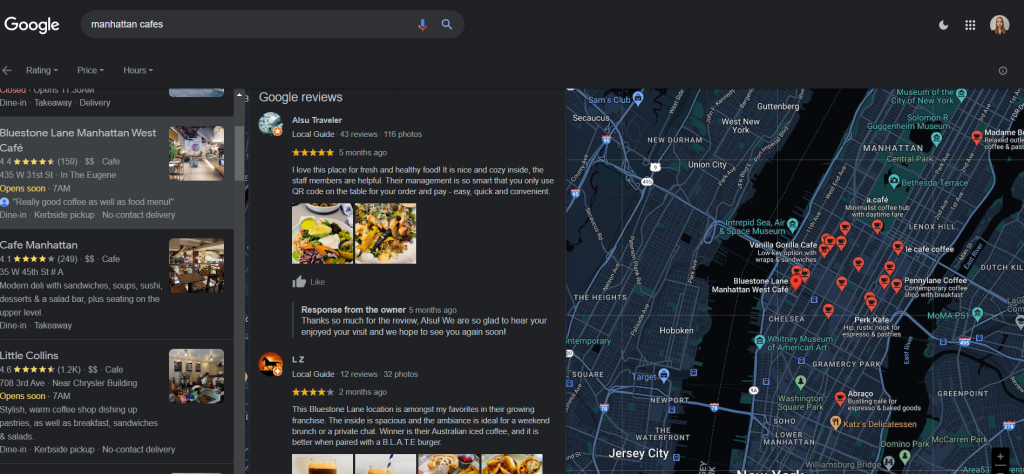
If you own a B2B company, you can ask your customers to leave reviews on websites like G2, Capterra, TrustRadius, etc. These resources accept reviews only from verified users, so the risk that you’ll get a review from a competing company (or a hater), like on Google reviews, is fairly low.
Now, when it comes to testimonials, businesses incorporate them differently. The most common way is to use them on landing pages to improve conversion rates. Here’s an example from Bizzabo, an event software company:
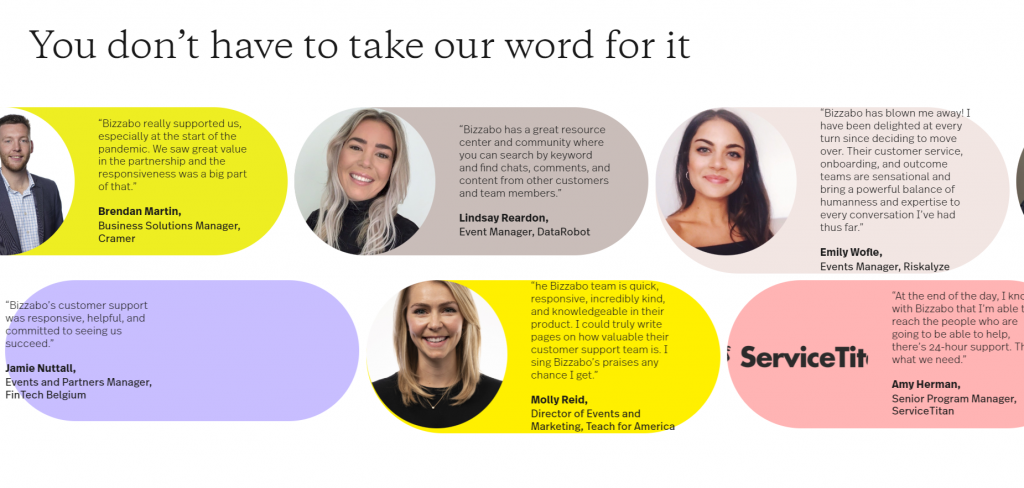
This screenshot comes from Bizzabo’s customer page, where you can read through different case studies and comments from the clients. You can also create such a page to help prospects at the decision-making stage.
Apart from that, it’s possible to feature reviews and testimonials in videos. A few sections earlier, we gave you an example from Databricks – you can film a few similar videos to boost brand awareness and build trust in your product. By the way, you can also follow Instagram marketing tips and best practices and showcase these testimonials to your Instagram followers to spread awareness.
Alright, it’s clear that customer reviews can improve your brand’s online authority. But what other content types have the same function?
Newsletters, no doubt. Let’s take a look at what they can do.
Type #7: Newsletters
An e-newsletter is an email message brands distribute among their subscribers to inform them of the latest company or industry updates or share news about the products and services.
If you’re worried about investing in newsletters thinking this content type won’t pay off, let us reassure you. According to HubSpot statistics, 81% of B2B marketers say an email newsletter is the most used form of content marketing, and 31% of the respondents say this is the best content to nurture leads.
What makes a good newsletter?
We’ve covered all the characteristics in our Email Newsletter Best Practices guide earlier, but let’s briefly recap them:
- An engaging and concise subject line
- A straightforward message in email content
- Personalization elements
- Stylistic consistency
- Optimization for mobile devices
Apart from that, a newsletter should target a segmented email list. If this factor is not present, you risk sending it to people who have absolutely no interest in your emails. As a result, you have an increased email bounce rate, unsubscribe rate, and worse performance across all other email marketing metrics.
If you’re looking for an example of a good newsletter, consider this one from Moosend:
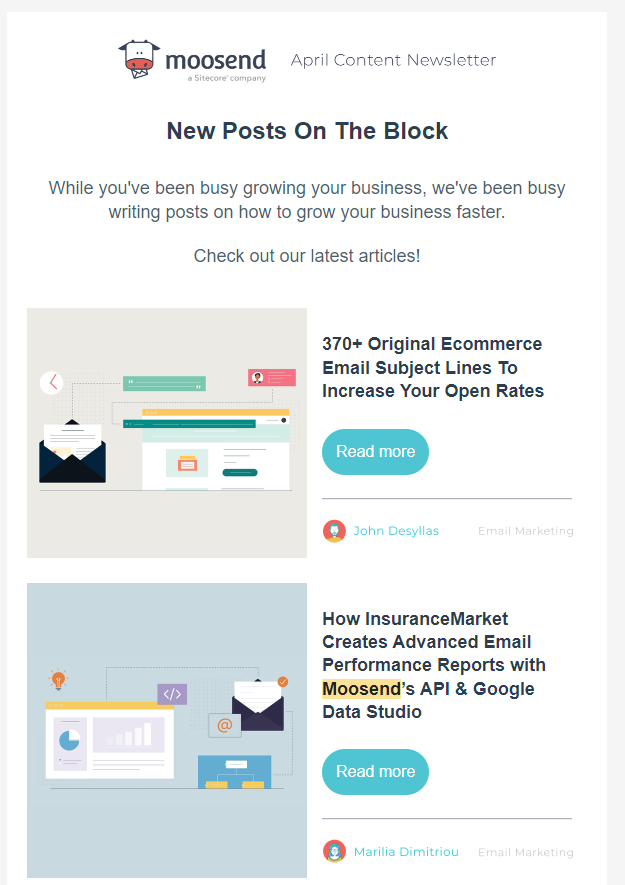
This is essentially a selection of blog posts on Moosend’s blog. However, it doesn’t include random articles but only blog posts on the email marketing topic. As a result, it targets a particular segment of Moosend’s audience interested in how to grow their business using email.
If you’d like to check out more outstanding email marketing examples, make sure to read this article.
Now, onto our next content type.
Type #8: Social Media Posts
Today, you will hardly find a business that doesn’t do social media. When compared to traditional marketing, social media marketing has a set of significant benefits:
- More specific targeting – social media platforms give you better opportunities to reach a particular audience.
- Fewer expenses – social media marketing is less expensive than traditional marketing.
- More ways to connect with new audiences – you can use digital advertising, content marketing, live streams, influencer marketing, and other opportunities to attract target buyers and prospects.
- Better sales – consumers are six times more likely to buy from a product page that includes social media images (such as user-generated content).
Of course, all of these benefits are only possible if you create the right social media content, which should have the following five characteristics:
- Entertaining
- Straightforward
- Aspirational
- Shareable
- Actionable
Essentially, an ideal social media post should engage the target audience, deliver a clear message that inspires your followers, be easy to share, and promote a specific action.
Here’s a great example of a post from Digital Olympus featuring these five characteristics:

expressing what people can get from this webinar, who it is for, and what you can learn. There’s also a CTA with a link inviting you to join the event.
By the way, an important factor in running a successful social media marketing strategy is to use marketing automation tools. We’ve made a round-up of such platforms in our Hootsuite Alternatives article, make sure to check it out. We also have many social media tool comparison articles on our blog.
Now, let’s see how case studies can enrich your content marketing strategy.
Type #9: Case Studies
A case study is an inbound content type that gives a detailed overview of a particular real-world instance of using a product or service and getting a successful result from it. Case studies are frequently used in B2B content marketing.
Why should you include case studies in your content strategy?
Here are some good reasons to consider:
- Raise brand authority. Case studies show your expertise and build your brand’s thought leadership in your industry.
- Increase sales. In this instance, case studies have the same function as testimonials – they prove that your product or service can deliver results and cater to the customer’s needs.
- Educate the prospects. Case studies share practical information about your offer, helping your prospects make a well-informed purchase decision.
You can even create an entire library of case studies, which can be especially beneficial if your product includes an extensive toolkit. Zendesk has such a library, which includes case studies from the happy customers:
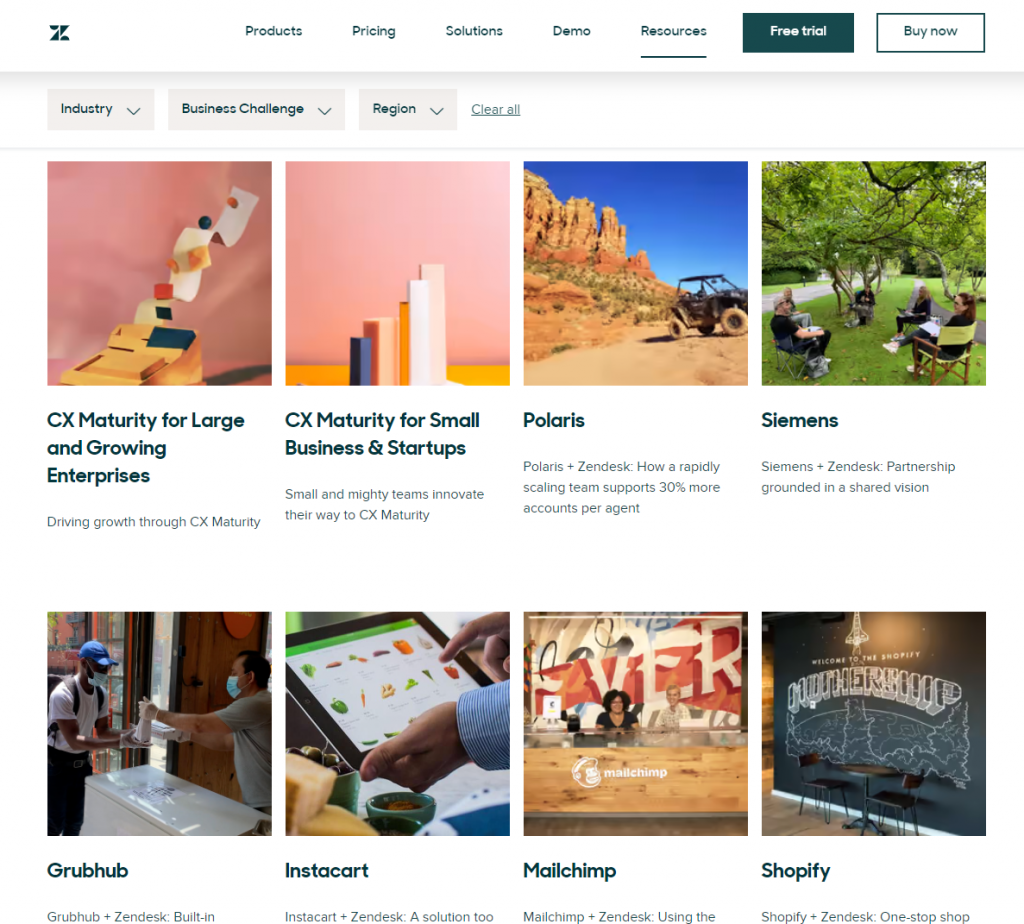
A typical case study should consist of four blocks:
- An introduction
- A section explaining the background of a brand’s cooperation with a specific client
- A presentation providing the main results of the cooperation
- A conclusion with data proving the results
If you want to create multiple case studies, you can follow Zendesk’s example and break them down by the types of business challenges your product has helped your clients solve.
Now, let’s talk about paid ads.
Type #10: Paid Ads
Paid advertising is a form of online advertising based on the bidding system – an advertiser pays to participate in an auction to be able to show their ads on a specific platform.
There are several types of paid advertising:
- SEM
- Display ads
- Social media ads on Facebook, LinkedIn, YouTube, Snapchat, etc.
- Retargeting
- Affiliate marketing
You might have heard that investing in paid ads is not as important as in organic ways of promoting your content, but it’s a false belief. Paid advertising is extremely useful, especially when you want to reach a big audience fast. Besides, paid traffic has a positive impact on brand recognition.
Also, if you’re afraid that your investment in PPC won’t pay off, TechJury reports that this content placement method brings a 200% ROI on average. The same source claims that 65% of internet users click on online ads. So, you have a good chance of driving more visitors to your website.
Great content for an ad always bets on visuals. Of course, you can use text, but it only serves to provide context – the main idea should be covered by an image or a video. In fact, the image can include a minimum of text and still serve as effective ad content. Here’s an example from H&M:
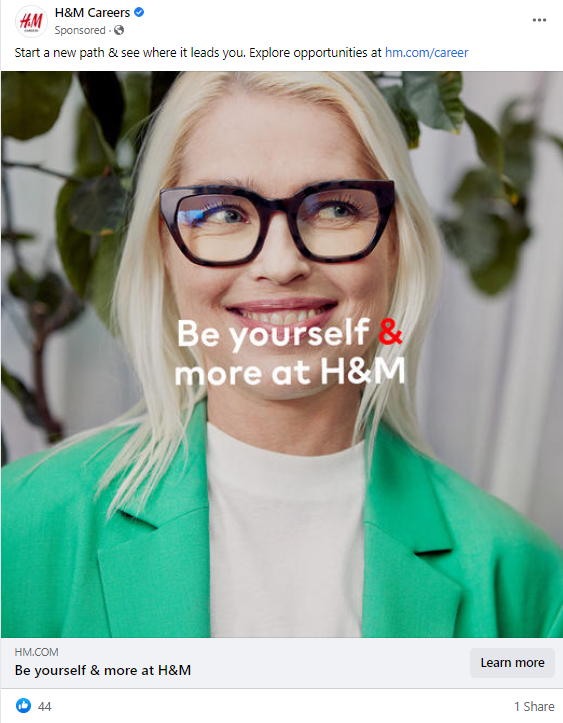
The text on the image says that there is a chance for everyone to show their personality and bring their ideas to life by starting a career at H&M. The caption above the image reiterates the same message and adds a link next to the CTA, which people can visit to learn more.
If you want to make your ad more interactive, it’s best to include a video. This way, you’ll also get more opportunities to tell more about what you’re offering to the target audience. It’s also possible to include memes if it’s appropriate for your target audience.
Alright, it’s time for our last content type – checklists.
Type #11: Checklists
Essentially, a checklist is a to-do list of things on any topic. You can use this content format to educate your target audience persona or help them master a particular skill.
What role can checklists play in your content marketing strategy?
One of the most frequent uses for this content type is lead generation. You can create a checklist, make it into a linkable asset, and attract potential customers. This is what Sendinblue did with its email marketing checklist: first, you need to provide your email details, and then you get the checklist sent to your inbox:
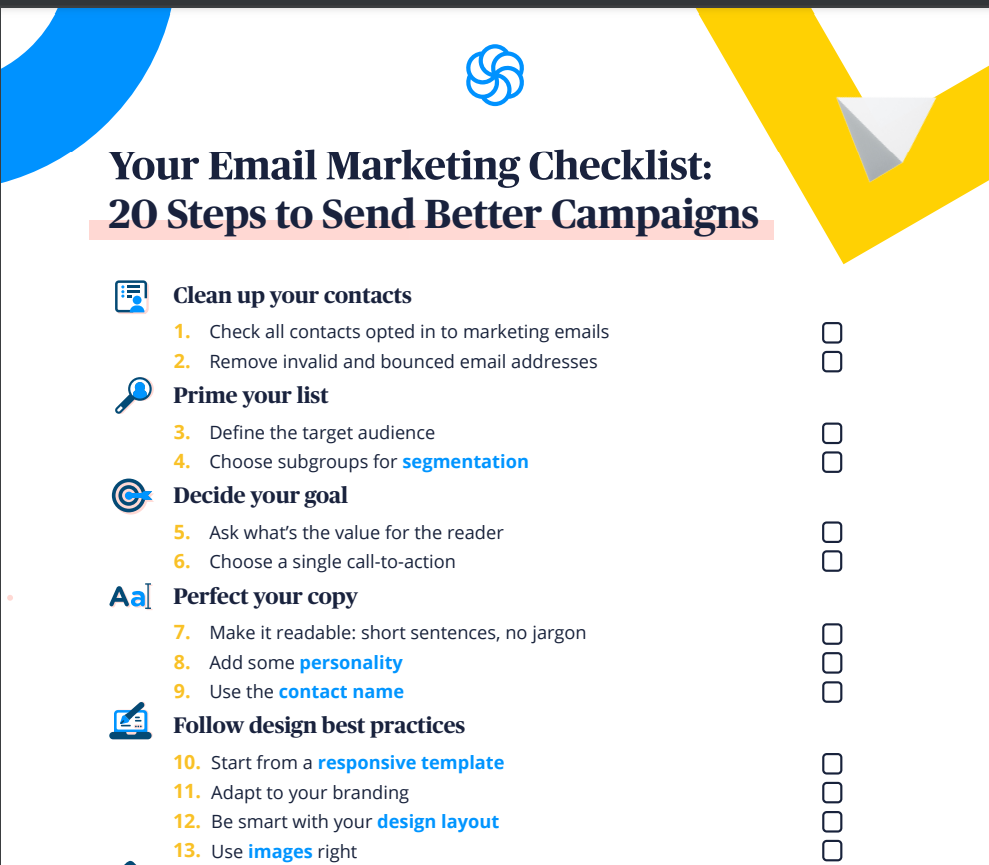
The beauty of checklists is that you can create one on any topic, but it’s important to make it deliver real value. The last thing you want to do is have someone download a piece of content that will just clutter their computer without bringing anything useful to the table.
Over to You
Content marketing is one of the most diverse digital marketing strategies – just look at how many options for content types you have! You can definitely let your creativity flow and create something that would help your brand stand out from the crowd.
However, there are also some rules to follow. For instance, it won’t make much sense to use newsletters if you don’t do email list segmentation. Also, blog posts won’t bring much traffic if you don’t optimize them for SEO.
Lucky for you, our blog can help you with all that. Make sure to check our previous articles and expand your knowledge on how to build a successful content marketing strategy!

Mariia is a content strategist and editor at Digital Marketer’s World. She is passionate about educating others on all things marketing and believes in the power of the written word.
